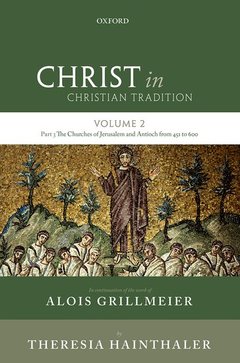Description
Christ in Christian Tradition: Volume 2 Part 3
The Churches of Jerusalem and Antioch
Authors: Grillmeier, SJ Alois, Hainthaler Theresia
Prefaced by: Louth Andrew
Language: English
283.81 €
In Print (Delivery period: 21 days).
Add to cart
Publication date: 08-2013
698 p. · 16.2x24.2 cm · Hardback
698 p. · 16.2x24.2 cm · Hardback
Description
/li>Contents
/li>Biography
/li>
This volume of Christ in Christian Tradition continues Alois Cardinal Grillmeier's pioneering work in the field of the early history of Christology. Here the focus is on Christianity in Palestine and Syria (the Fertile Crescent) after the Council of Chalcedon and before the advent of Islam. A consideration underlying the entire book is whether we can speak of a consistent Christology throughout the Christian East before Islam and to what extent the Christian East retained the biblical message of Jesus, despite the various divisions that occurred within its borders. Chapters have been collected, edited, and reworked by Theresia Hainthaler with additional contributions from Tanios Bou Mansour and Luise Abramowski. The first part of this volume examines Christology in Palestine from Chalcedon until Islam, including the theology of monks and ascetics, the School of Gaza, and liturgy. The second part is devoted to the Christology in the patriarchate of Antioch from 451 to the end of the sixth century. In 1951 Alois Cardinal Grillmeier (1910-1998) first published Das Konzil von Chalcedon , a work focused on the pre-Chalcedon period and the events of the Council in 451. The first chapter of this would become the first volume ofChrist in Christian Tradition . The work appeared in English in 1965. In 1986 Volume 2/1 appeared with a foreword explaining the author's intention to provide a comprehensive study of Christology from the beginning up to c.800. This was translated to English in 1987. Three further volumes appeared: 2/2 (1989, translated 1995), 2/4 (1990, translated 1996) and the present volume, 2/3 (2002). This volume completes the translation of the published volumes into English. Editorial work continues on volume 2/5 which has yet to publish in German.
I: Christology in Palestine in the Post-Chalcedonian Centuries until the Appearance of Islam. 1. Palestine and its Christological Groupings after 451. 2. The Actual Christology of the Palestinian Church. 3. A Synthesis of Palestinian Christology at the End of the 6th Century According to Terms and Formgeschichte: Pamphilus the Theologian. 4. Retrospect and Prospect. II: Christology in the Patriarchate of Antioch after 451 to the End of the 6th Century. I: Placing the Patriarchate of Antioch in Context. 1. Extent and Organization of the Patriarchate of Antioch. 2. The Hierarchical Split of the Patriarchate of Antioch. 3. On Pre-Islamic Christianity among the Arabs in the Sphere of Influence of the Patriarchate of Antioch. 4. The School of Antioch and Theological Schools in the Patriarchate of Antioch. 5. The Persian Debater Symeon of Beth Ar am and his Anti-Nestorian Position. 6. The Tritheist Controversy in the 6th Century and its Importance in Syriac Christology. 7. The Christological of the Patriarchs Occupying the Throne of Antioch. II: Greek Theology. 1. Pseudo-Dionysius Areopagita. 2. Ephraem of Antioch and His Neo-Chalcedonism. 3. Anastasius, the Great Bishop of Antioch. 4. A Christological Controversy among the Severans at the End of the 6th Century: The Conversion of Probus and John Barbour to Chalcedonianism. III: Syriac Theology. Introduction: On Syriac Christology before Chalcedon. 1. The Christology of Jacob of Sarug. 2. The Christology of Philoxenus of Mabbug. 3. From the Controversy on Unus ex Trinitate passus est : The Protest of Habib against Philoxenus Epistula dogmatica to the Monks. Bibliography. Indices.
Jesuit theologian, Alois Cardinal Grillmeier (1910-1998) wrote 12 major books and several hundred academic articles during his lifetime. Christ in Christian Tradition is his best known work, looking at the development of Christology from early Christian times to the ninth century, and drawing particularly on the traditions of the Eastern Christian Church.
© 2024 LAVOISIER S.A.S.




